Are you ready to take your box jump game to the next level?
This blog will cover everything you need to know as a functional fitness or as a CrossFit athlete.
From proper form and technique to my top tips if you're not jumping as high as you want, and even new rules released by CrossFit HQ that have changed the game in recent years.
All of this and more - let's jump in!
The Standards
Okay, so let's talk about a standard box jump.
In most CrossFit workouts, if you see box jumps, all you have to do is jump on top of the box.
Then, the movement standard is that you need to land on top of the box and get full hip and knee extension.
Your hips and knees need to be fully extended so you have control on top of the box and not fall. I've definitely seen some people stand on the top of the box, but when they try to stand they're falling back down.
Technically, that's a no rep because there is a lack of hip extension or lack of knee extension.
Now a thing to note is you don't have to have your full feet all the way on the box, but it's certainly something that we suggest.
Another standard that we must talk about when it comes to the box jump is you need to jump with two feet.
So it's a two-footed takeoff.
What that means is you can't prance onto the box - that's technically an illegal box jump.
You can't lead with one leg, and basically just jump off with one leg. Technically, by most standards, that will be a no rep.
We need to have a two-footed takeoff and landing - and then what you do after that all depends on the standards.
The standard for most CrossFit competitions, especially The Open, is you can either jump down or step down.
Recently, in the CrossFit Open, as of this article, they actually required you to step down from box jump overs to prevent injury.
We're going to get into that a little bit later, but let's just talk about the two different versions of how to get down.
The Different Versions
One of the first and fastest box jump versions is The Rebound box jump.
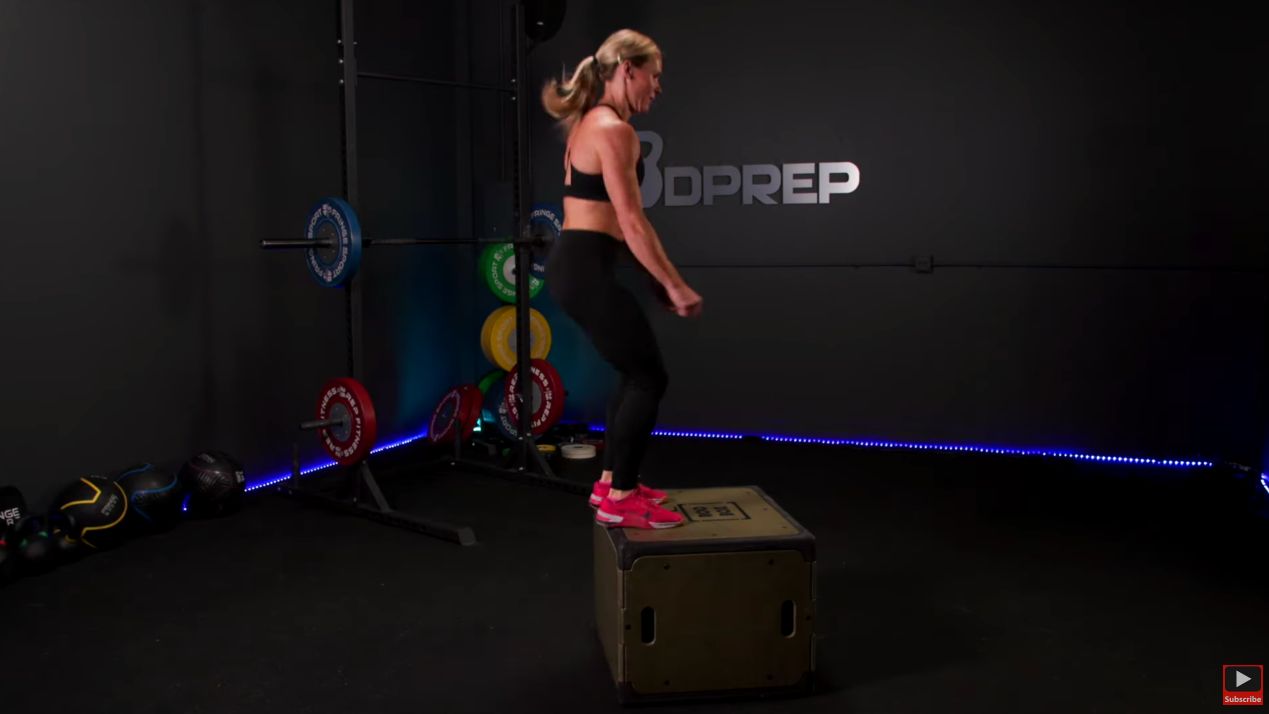
The Rebound Box Jump
So you have to jump all the way on top of the box. But then, when you jump down, you need to spring back up to the next rep immediately.
Before you do this, even though this is the fastest version of a box jump, I personally know several athletes, very, very fit, highly mobile athletes that have exploded their Achilles tendon, or both of them, by doing rebounding box jumps.
I personally don't think they're worth it.
But this wouldn't be a great blog post without mentioning what they are.
So you need to jump fully on the box and get that full hip extension because remember, you have to get a full hip extension and the extension with control.
And then from there, you jump back down, and then immediately spring back up with no pause. What's happening here is you're landing on the ball of your foot with basically a spring and immediately jumping back on the box.
That's where that impact tends to catch people. I've seen a lot of people get injured doing that.
So while it's the fastest, I don't necessarily recommend it.
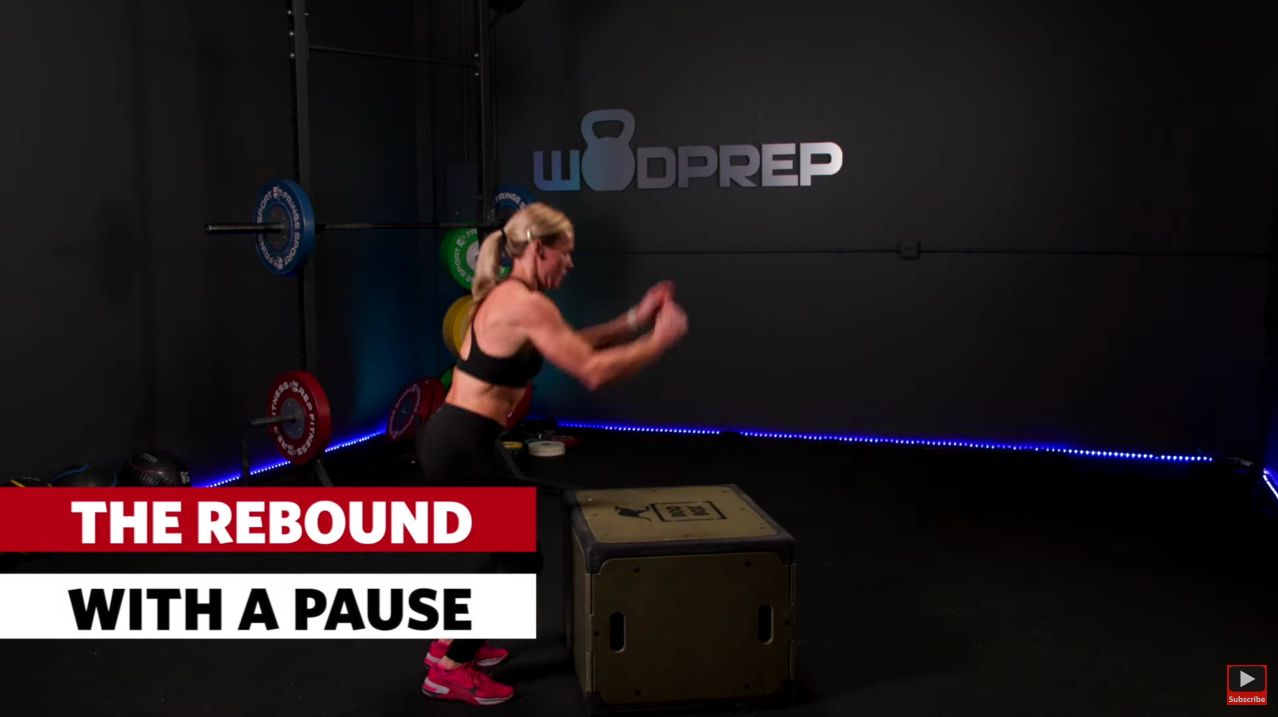
The Rebound With a Pause
Next, is the rebound with a pause, it's the same as the rebound, but when you jump back down from the box you pause instead of jumping back into your next rep.
When you pause a little bit when you jump back down, that reduces the impact on your Achilles, so you will have less chance to pop one of them.
A lot of times for me, what I do is I tend to jump up, and I jump down, and I just kind of like I rock back on my heels.
When I rocked back on my heels just a little bit, I knew that was taking the pressure off that Achilles and that sets me up for the next rep.
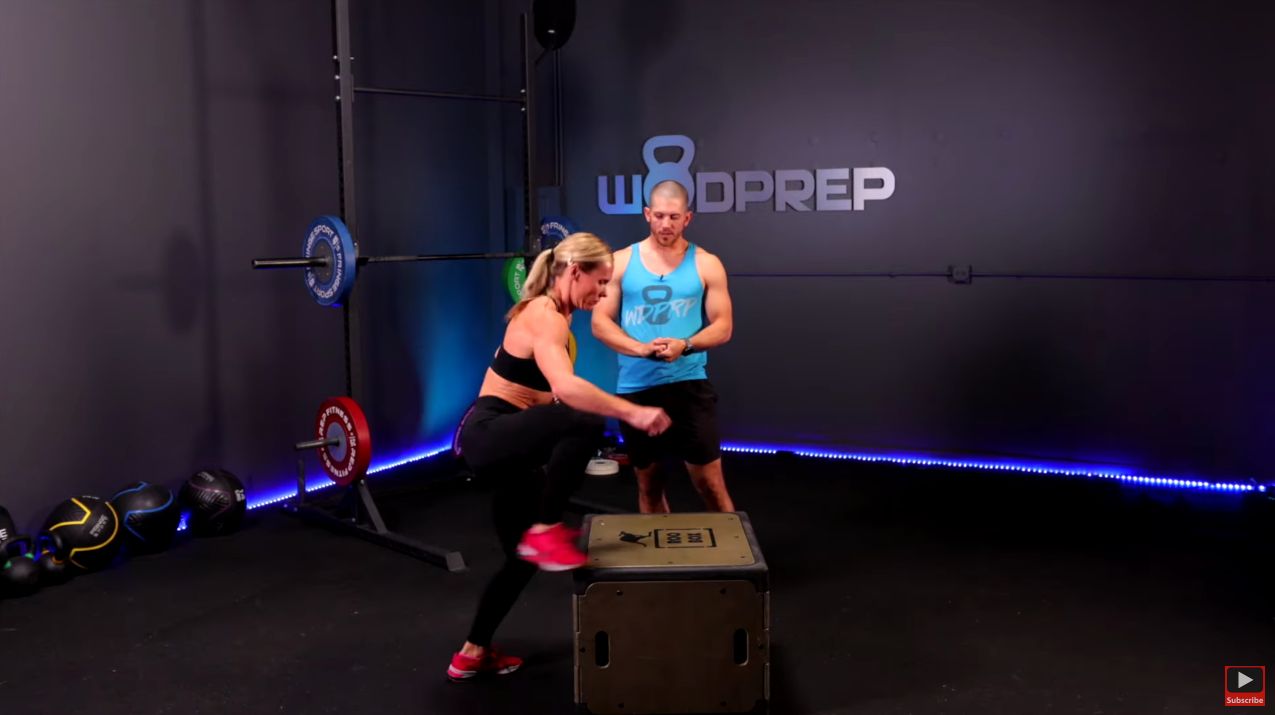
Jump Up, Step Down Box Jump
The next box jump we're gonna talk about is the jump up and step down box jump.
It's the same thing, getting those hips in the extended position as soon as you get the full extension with control, and then immediately stepping down.
It's fast and it has a really good cadence.
It's also the one that I really like to teach my athletes; it just allows you to keep a nice steady pace, you're not going to pop an Achilles or tear something, and there's less impact on that jump down.
As soon as you get down from the rep, you will get down, and your hands are ready to go, and immediately jump back up.
So even though you're not rebounding, you're barely tapping that secondary foot, that trailing leg comes down, boom, immediately back up.
And it's a really, really efficient way to do box jumps.
A box jump article wouldn't be complete without at least mentioning a couple of other different versions.
We're just talking about the standard box jump here.
But there's also a box jump over, and the burpee box jumps.
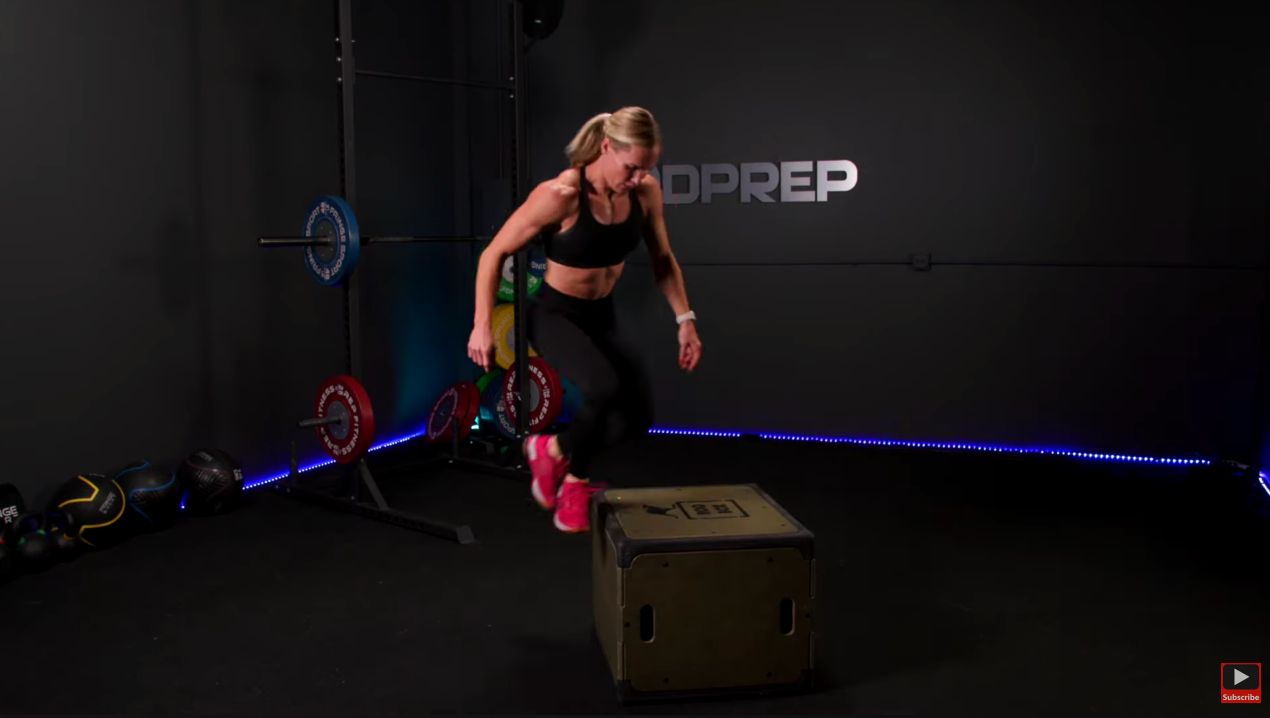
The Box Jump Over
The box jump over has a different standard than a normal box jump.
Remember that a normal box jump needs hips, and the knees fully extended at the top, but for a box jump over, the only standard is you start on one side of the box, have two feet to take off, and end up on the other side of the box.
Usually, in the CrossFit open recently, the standard was that you actually had to make contact with the top and step down.
So first, let's explain a jump up and jump over.
When you do a jump up and jump over and you're just rebounding, you'll notice you're not getting full hip extension at the top - that's totally legal.
Because the standard for usual box jump overs is you start on one side, and you end up on the other.
Technically, if you wanted to, and I've seen some competitions that do this, where you can jump completely over the box.
But it's not recommended because you're gonna burn out.
Recently in the open, they had a new standard where you have to jump up and step down.
So when getting on top of the box, you're actually stepping down and setting up for the next round.
If you want more nitty-gritty details on the perfect efficiency, and the perfect stepping sequence for box jump overs, you can go check out some of my previous CrossFit open videos where they programmed box jump overs and I go into a lot more detail on the efficiencies there.
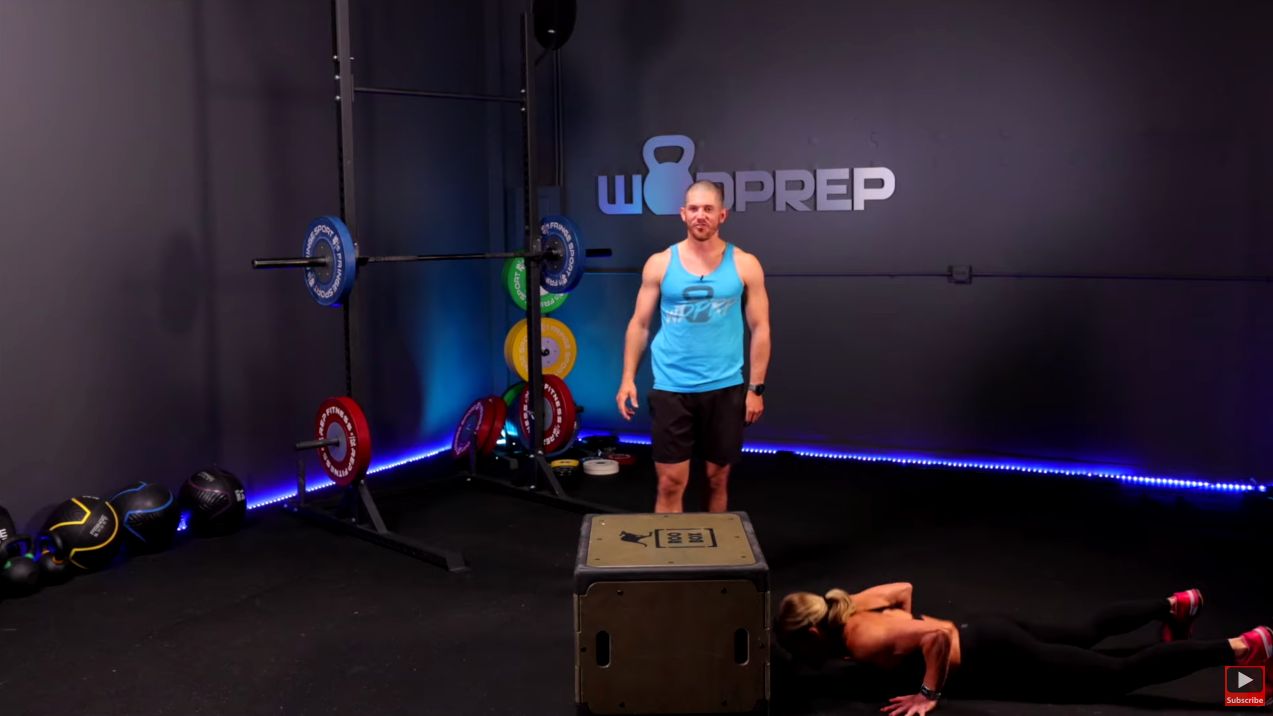
The Burpee Box Jump
Next, the burpee box jumps overs, there are a million different varieties.
If you want to learn more about burpees, we have loads over on the WODprep YouTube channel.
I have a whole video where I go into lots of detail about the various types of burpees and how to do that.
But the standard of a burpee box jump over essentially depends on whether it's box-facing or a normal one.
Normally, your chest hits the deck so your chest hits the ground on one side, you jump with two feet and end up on the other side.
So it's literally just like the box jump over - you just have to throw a burpee in on the front end of it.
The standard here is your chest touches the deck and then you end up on the other side of the box.
Now the thing is when you're counting the burpee box, the rep isn't complete until you get to the other side of the box.
You have to make sure you get over the box for it to be complete.
That's a personal pet peeve of mine.
Tips
So let's talk about a few tips that will help you become a better box jumper.
Tip 1: Use Your Arms
Number one is to remember to use your arms.
While the box jump is very leg dominant, you're going to feel most of the fatigue in your legs if you're not using your arms to get on the box, you'll be doing box jumps very inefficiently.
You need your arms to swing forward and back behind your body, and then they end up in front of your body.
That's going to generate a lot of momentum.
Tip 2: Look At The Target
Typically, I like to see athletes get at least three-quarters of their foot on the box, ideally more, because if I aim to get my whole foot on the box, the chances of me failing, falling, tripping, and slipping off the edge are very low.
But for the athletes who only get their toes in the box, I've seen a lot of times where they slip, miss, and boom their shin connects with the box -now they're bleeding everywhere.
Another thing that I see is many people falling because they're just not looking where they're jumping. I think that's kind of ridiculous.
If I want to jump onto the box, I'm gonna look there until I land.
But some people look up and you can't even see the box in their peripheral vision, it's very dangerous, and there's a chance you're going to miss it.
So keep your eyes on the target, and try to get your foot all the way on the box, I wouldn't necessarily recommend jumping very far onto the box, because that's just inefficient.
But if you can just get your heels barely over the edge, I think that's a really, really great place to be for the box jump.
Tip 3: Avoid Full Squats
So the last thing I want to talk about is a common issue that I see with a lot of beginner box jumpers, which is they end up being very squatty.
Doing a full squat on top of the box would be a no rep.
For whatever reason, some people don't know how to engage their posterior chain so they keep their torso super vertical, and they land in a super squatting position.
And I've seen people do box jumps where every single time they jump on the box, they're like ass-to-grass squatting.
That is very, very inefficient because not only do you have to jump, but you're also adding a squat in there.
To properly execute a box jump, start by hinging at the hips and engaging the glutes and hamstrings to store potential energy.
Keep your hands in a jumping position and explode upwards to achieve full hip extension.
When you are landing, you need to aim for the same position as when you started your jump.
Aim for slow, deliberate movements; focus on the good form each time you jump.
If I told you to jump as high as you possibly could without a box or anything, you're going to naturally hinge forward pretty far and then you're gonna explode up because your body naturally knows how to generate that upward momentum.
Tip 4: Use a Box Jump Scale
So if you're someone that struggles to jump onto a normal-size box, the one we use is a standard three-by-one box.
We have three different sizes, we have 20 inches, 24, and 30 on this standard three-by-one box.
30 inches is normally what these boxes' highest setting is, then we have 24 inches, and then 20 inches, and your box might be different, but let's say you're having issues jumping to the standard, maybe 20 inches is still too difficult for you.
You're just too afraid to jump, you can't figure it out, you run up to it, and then you freeze.
It's a real thing, box jump fear is totally normal.
I've seen it in a lot of different athletes and it's okay, I'm going to teach you how to get around that.
So the first thing we do is get rid of the box and replace it with something shorter like weights piled on top of each other.
What that is doing is scaling the range of motion.
So if you can't jump 20 inches, guess what? It'll help you to see what you can jump on to.
The same rules apply, so hinging up and using all the same mechanics.
If it's too easy for you then it's too short.
Our goal here is just to keep adding height to your "box."
You need to keep adding weights or keep adding height to your makeshift box, until, eventually you're freaking out.
I've seen people in one day in one session, use this technique; they just keep adding plates, do a few jumps, add a plate, do a few jumps, add a plate, and then before they even know it, they're jumping higher than the lowest setting of their box, and they're just like, 'Oh my God, how did I that? How did that happen?'
It's called progressive overload, we're just slowly but surely exposing ourselves to a higher jump.
Using all the same rules, and all the same mechanics, the good thing about the bumper plates, especially the heavier ones, is they are really sturdy, and the chances of the plate flying or falling or anything like that, are very minimal.
Normally, the edges are less sharp on these than they are on a traditional box, so if you're having trouble on a traditional box, just try stacking plates until you get to or above the standard that you're trying to jump to.
Then move back to the box and see if that works for you.
So the final scale, the final modification that I've used with success, is simply adding a PVC pipe.
So for athletes, for whatever reason, they're having trouble jumping onto the sharp square rectangular box. I'll take a plate, put it on top of the box, and put a PVC pipe under the plate.
You're still jumping to the same height that would be required to jump onto the 20-inch box.
For whatever reason, it removes the mental barriers of having a sharp, rectangular object.
So really, simply, you can just jump over and back. I've seen people jump over this laterally.
She's squaring up to the PVC, doing all the same mechanics that we talked about. And she's jumping up and over.
But if you do fail, the chances of the PVC actually hurting you are very, very low compared to a sharp box.
To Summarize
With this comprehensive guide, you're now ready to take your box jump game to the next level!
Whether you're a functional fitness or CrossFit athlete, you can now master form and technique and reach new heights with the tips and tricks provided in this blog.
I have a completely free training guide, I'd love to send you. It's actually an ebook that I wrote and we've had a lot of great feedback from it.
So if you want to learn how to become a better RX athlete, climb the leaderboard, and get better at this fun thing, we call CrossFit, then click here.
Good luck!
